- Table View
- List View
Clouds over California
by Karyn Parsons"An absolute gem!" —Lisa Moore Ramée, author of A Good Kind of TroubleA moving novel about how a girl's family and friendships are turned upside down—just as the world is changing in 1970s Los Angeles, for fans of Rita Williams-Garcia and Renée Watson. Stevie&’s life is fluctuating rapidly. She's starting over in a brand new middle school. Quiet and observant, it's hard for her to make friends. Plus, her mind is too occupied. The tension in her home is building as her parents' arguments are becoming more frequent. To top it all off, Stevie's older cousin Naomi is coming to live with the family in an attempt to keep her from a "bad" crowd—The Black Panthers. Stevie agrees to keep Naomi's secrets. She's the cool big cousin, after all, and Stevie can't help but notice the happy, positive effect the Black Panthers are having on Naomi's confidence and identity—just like how Mom is making decisions for herself, even when Dad disapproves. Stevie feels herself beginning to change as well. But one thing remains the same: she loves both of her parents, and she loves them together. Can her family stay in one piece despite the world shifting around them?
Cloudstreet: A Novel
by Tim Winton“Cloudstreet gets you inside the very skin of postwar working-class Australians the way Joyce makes you feel like a turn-of-the-century Dubliner.” —Elizabeth Ward, The Washington PostAfter two separate catastrophes, two very different families leave the country for the bright lights of Perth. The Lambs are industrious, united, and—until God seems to turn His back on their boy Fish—religious. The Pickleses are gamblers, boozers, fractious, and unlikely landlords.Change, hardship, and the war force them to swallow their dignity and share a great, breathing, shuddering house called Cloudstreet. Over the next twenty years, they struggle and strive, laugh and curse, come apart and pull together under the same roof, and try as they can to make their lives.Winner of the Miles Franklin Award and recognized as one of the greatest works of Australian literature, Cloudstreet is Tim Winton’s sprawling, comic epic about luck and love, fortitude and forgiveness, and the magic of the everyday.“Winton is a one-man band of genius.” —Carolyn See, Los Angeles Times“Nothing short of magnificent . . . A wonderful read.” —Andrew Yule, Time Out (New York)“[A] marvelous postmodern novel of family life . . . One of those rare novels that warm the heart, as well as spark the imagination.” —Kirkus Reviews
Clover (Katy #4)
by Susan CoolidgeThis book continues the author's What Katy Did series, focusing on her younger sister Clover, who has now taken over running the busy Carr house. This is the fourth book of the series beginning after Katy's wedding. Clover, the "woman of the house" is now in her early twenties and "little" Phil is now twelve. After Phil's serious illness during the winter, Dr. Carr sends him, with Clover and a "chaperone" to watch over him, to the mountains of Colorado for the healing fresh air. Clover makes many new friends readily in their rooming house and is befriended by Dr. Carr's friend, Dr. Hope, and his wife. Clover is reunite with a dear cousin, Clarence Page, now a rancher with an English partner, who happens to live nearby. It is a warm tale of coming of age, healing and learning to make your way in the new West frontier.
Clover Hendry's Day Off
by Beth MorreyA hilarious and empowering perimenopausal Ferris Bueller&’s Day Off, about Clover Hendry, 46, and the day she decides to stop keeping the plates spinning, say F@#! it all, and finally get hers.Today is not the day to mess with Clover Hendry. Clover hasn&’t said &“No&” a day in her life. Until today. Normally a woman who tips her hairdresser even when the cut is hideous, is endlessly patient with her horrendous mother, and says yes every time her boss asks her to work late—today, things are going to be very different. Because Clover is taking the day off. Today, she&’s going to do and say whatever she likes, even if it means her whole life unravels.What made Clover change her ways? Why doesn&’t she care anymore? There&’s more to this day than meets the eye.Clover Hendry's Day Off is a joyful, raging, galvanizing story about putting life on pause, pleasing yourself, and getting your own back. Whatever it takes. Because when Clover stops caring, she can start living.
Club Dread (Hunted #2)
by Walter SorrellsIn this follow-up to "Fake ID," Chastity and her mother have just settled in San Francisco, where Chass is starting her own band. When a pop star is killed, Chass gets involved in the dangerous underground club scene to solve the murder.
Club Sandwich: A Novel
by Lisa SamsonHey, Friend- Do you know what it's like give to 100 percent and still feel like it's not-and you're not-enough for anybody? To be caught between caring for an aging parent and raising young children? I lived in that place for four years. Ivy Schneider lives in this place, too, and she isn't at all happy about it. Her husband Rusty spends ten months a year on the road singing in a gospel quartet, and her mom gets sicker every day, requiring increasingly more care and time. Ivy's dad took off years ago but still comes around-for free meals. Her brother and sister are more than happy to let responsibility rest on Ivy's shoulders. Maybe she could handle it all if only her darling three-year old terror, Trixie, would just "go" on the potty. Who will take care of Ivy while she takes care of the world? No one, it seems. Then Ivy runs an ad in the paper to find folks like herself: women of the "sandwich generation," squeezed between the demands of raising young children and caring for an aging parent. Soon she and the other women of Club Sandwich are building uncommonly deep friendships, witnessing the reality that in fact no woman can be everything to everybody, and discovering firsthand that they can do more than they imagined possible with the help of each another and with a strong dose of faith. If your life is about caring for others, I dedicate this book to you. Welcome to the club. You are most definitely not alone. Grace, Lisa
Clueless
by Bobbie ReidAsk any woman: some men don't "get it" when it comes to the opposite sex. Ask any man and there's a good chance he'll agree. So how can men and women communicate and fulfill their very different needs and desires? In Clueless, Bobbie Reid provides witty insights, real solutions and sage advice for overcoming the male/female conundrum, one step at a time, to achieve happier,more fulfilling relationships.
Clues to the Universe
by Christina LiThis stellar debut about losing and finding family, forging unlikely friendships, and searching for answers to big questions will resonate with fans of Erin Entrada Kelly and Rebecca Stead.The only thing Rosalind Ling Geraghty loves more than watching NASA launches with her dad is building rockets with him. When he dies unexpectedly, all Ro has left of him is an unfinished model rocket they had been working on together.Benjamin Burns doesn’t like science, but he can’t get enough of Spacebound, a popular comic book series. When he finds a sketch that suggests that his dad created the comics, he’s thrilled. Too bad his dad walked out years ago, and Benji has no way to contact him.Though Ro and Benji were only supposed to be science class partners, the pair become unlikely friends, and Ro even figures out a way to reunite Benji and his dad. But Benji hesitates, which infuriates Ro. Doesn’t he realize how much Ro wishes she could be in his place?As the two face bullying, grief, and their own differences, Benji and Ro try to piece together clues to some of the biggest questions in the universe.A Washington Post KidsPost Summer Book Club selection * A Junior Library Guild Selection * A Bank Street Best Book of the Year
Clydeo Takes a Bite Out of Life (Clydeo)
by Jennifer AnistonFrom global superstar and everyone’s F-R-I-E-N-D Jennifer Aniston comes a delectable and fun-filled picture book about self-discovery and self-confidence starring her food-loving dog Clydeo! Everyone in the Clyde family knows what their “thing” is, except Clydeo.Clydeo doesn’t love to surf like his uncle. He isn’t into painting blindfolded like his cousin. And digging for dinosaur bones like his aunt is definitely not his thing. Clydeo tries everything he can think of, but nothing seems to make his world sparkle. Will Clydeo ever find what he loves to do most?Find out in this relatable and heartwarming story brought to you by actress, producer, and entrepreneur Jennifer Aniston.
Co-Parenting Works!: Helping Your Children Thrive after Divorce
by Tammy G DaughtryWhat if your child’s “life-after-divorce” could be better than you’ve hoped for? As the post-divorce dust settles, your child’s chances of leading a healthy, successful life are directly linked to how you and your former spouse relate. So instead of listening to statistics, read this book to discover real world co-parenting strategies from author, counselor, and co-parent Tammy Daughtry. Discover how you can make positive co-parenting work for you and your child by: • Understanding how today’s actions will affect your child in five, ten, and twenty years • Teaming with your child’s co-parent to develop strategies in the best interest of your children • Helping your child feel at ease in both homes • Increasing your child’s self-esteem while minimizing anxiety • Integrating stepparents into your co-parenting team Co-parenting isn’t easy. But with these strategies for success, you’ll be prepared to create an enjoyable childhood and a healthy upbringing that will impact your child for a lifetime. Take heart—the future can be better and brighter than you’ve dared to hope.
Co-Parenting from the Inside Out: Voices of Moms and Dads
by Edward Kruk Karen L. KristjansonKaren L. Kristjanson shares the stories of a variety of divorced and separated couples who co-parent. Effective co-parenting, or sharing significant parenting time with an ex-spouse, is one of the best gifts separated parents can give to their children. The interviews in Co-Parenting from the Inside Out are with real moms and dads in diverse circumstances, showing them making choices, sometimes struggling, and often growing. Their stories offer insights into wise decision-making, as well as practical strategies that strengthen families. Parents can see that they are not alone as they navigate their feelings and build a future. While pain exists in most stories, there is also hope. Co-parents often feel that they have become more confident and compassionate, and parent better than before. The effects of their personal growth and their children’s are the silver lining in the dark pain of divorce. Karen L. Kristjanson has brought together real life co-parenting stories that inspire separated parents and help them understand co-parenting better, offering practical tips and tools that directly benefit families.
Coaching Champions
by Jess GibsonAlthough mentoring is a popular buzz word today, throughout history dominant cultures have passed down the importance of teaching the next generation not only a trade, but ethics, spirituality, and the rewards of a job well-done. Jess Gibson knows that success is far more than merely developing skills. Just as vital is developing character. Future leaders invariably learn how to achieve their most grandiose dreams when they are fortunate enough to be taken under the tutelage of a proven leader - a mentor with the experience of years who cares about a young lion yearning to conquer the world. How can we be mentors? Thought-provoking answers fill this conversational, anecdote-packed, how-to book written to appeal any reader.
Coaching nutricional para niños y padres: Tu hijo querrá comer bien
by Yolanda Fleta Jaime Giménez¿Has intentado alguna vez que tus hijos coman sano y no lo has conseguido? Muchas veces, lo que falla al procurar que nuestros hijos coman mejor son las estrategias con las que afrontamos este cambio. Quizá se deba a la falta de tiempo para preparar meriendas sanas, al poco autocontrol de los niños frente a los dulces o a no tener claro qué alimentos son los más saludables y adecuados. Este libro aporta información nutricional y estrategias de coaching nutricional para conseguir no solo que nuestros hijos coman sano, sino también que se sientan mejor con ellos mismos y desarrollen su inteligencia emocional. Con los ejercicios que se proponen, podremos identificar cual es la motivación de cada miembro de la familia para alimentarse bien y fijar objetivos realistas y asequibles, renovaremos la relación con la comida (y nos despediremos del azúcar), trabajaremos la disciplina, sabremos qué alimentos nos convienen y cuáles no, yaprenderemos a elaborar un menú semanal todos juntos.
Coaching nutricional para niños y padres: Tu hijo querrá comer bien
by Yolanda Fleta Jaime Giménez¿Has intentado alguna vez que tus hijos coman sano y no lo has conseguido? Muchas veces, lo que falla al procurar que nuestros hijos coman mejor son las estrategias con las que afrontamos este cambio. Quizá se deba a la falta de tiempo para preparar meriendas sanas, al poco autocontrol de los niños frente a los dulces o a no tener claro qué alimentos son los más saludables y adecuados. Este libro aporta información nutricional y estrategias de coaching nutricional para conseguir no solo que nuestros hijos coman sano, sino también que se sientan mejor con ellos mismos y desarrollen su inteligencia emocional. Con los ejercicios que se proponen, podremos identificar cual es la motivación de cada miembro de la familia para alimentarse bien y fijar objetivos realistas y asequibles, renovaremos la relación con la comida (y nos despediremos del azúcar), trabajaremos la disciplina, sabremos qué alimentos nos convienen y cuáles no, yaprenderemos a elaborar un menú semanal todos juntos.
Coast Road: A Novel
by Barbara DelinskyHailed as &“a heartwarming story&” (Star Tribune, Minneapolis), a celebration of what matters most in life, Barbara Delinsky&’s profoundly moving New York Times bestseller is as richly textured and captivating as the Northern California landscape in which it is set.Jack McGill chose his architectural career over his family, and returned home from yet another business trip to find that his wife, Rachel, had left him. Now, six years later, a car accident has left Rachel clinging to life, and she and their two daughters desperately need him. Putting work on hold for the first time in his life, Jack decides to sit by his ex-wife's bedside. As he meets Rachel's many new friends, and tries to cope with two teenage daughters and their problems, he learns more about a woman he never really knew, her expressive art, and the secret that made her leave. Much to his astonishment, Jack begins to see Rachel, his daughters, and the story of his marriage with new eyes.
Coast to Coast
by Betsy ByarsWhen Birch agreed to one last flight in her grandfather&’s Piper Cub, neither knew it would be a life-changing tripBirch&’s grandfather, &“Pop,&” wants to take his plane out for one more trip before moving into a retirement home. He wants to take Birch along with him, which sounds like a fine plan—until the two decide to turn the short flight into a cross-country adventure without telling Birch&’s parents. As grandfather and granddaughter soar westward across strange, beautiful landscapes, Birch begins to learn more about her past, a grandmother she lost, and a family member she never knew she had. Coast to Coast is a grand adventure; a heartwarming story of family revelations; and a panoramic view of the United States by air. This ebook features an illustrated biography of Betsy Byars including rare images from the author&’s personal collection.
Coaster
by Betsy DuffeyWhile secretly building a roller coaster in the woods, twelve-year-old Hart tries to come to terms with his parents' divorce and his mother's new relationship with a television weatherman.
Cobble Hill: A Novel
by Cecily von ZiegesarThe #1 New York Times bestselling author of the Gossip Girl series brings her sharp-eyed and irresistible wit to this &“quirky novel of lovable misfits&” (Publishers Weekly) chronicling a year in the lives of four families in an upscale Brooklyn neighborhood as they seek purpose and community—until one unforgettable night at a raucous neighborhood party knocks them to their senses.Welcome to Cobble Hill. In this eclectic Brooklyn neighborhood, private storms brew amongst four married couples and their children. There&’s ex-groupie Mandy, so underwhelmed by motherhood and her current physical state that she fakes a debilitating disease to get the attention of her skateboarding, ex-boyband member husband Stuart. There&’s the unconventional new school nurse, Peaches, on whom Stuart has an unrequited crush, and her disappointing husband Greg, who wears noise-cancelling headphones—everywhere. A few blocks away, Roy, a well-known, newly transplanted British novelist, has lost the thread of his next novel and his marriage to indefatigable Wendy. Around the corner, Tupper, the nervous, introverted industrial designer with a warehouse full of prosthetic limbs struggles to pin down his elusive artist wife Elizabeth. Throw in two hormonal teenagers, a ten-year-old pyromaniac, a drug dealer pretending to be a doctor, and a lot of hidden cameras, and you&’ve got a combustible mix of egos, desires, and secrets bubbling in brownstone Brooklyn. &“Breezy, witty, and compulsively fun to read&” (Kirkus Reviews), Cobble Hill is highly entertaining portrait of contemporary family life and the colorful characters who call Brooklyn home.
Cobwebs
by Karen Romano YoungA girl walks across the Brooklyn Bridge, a backpack full of knitting slung over her shoulder, a green fish kite in her hand. A boy balances on the bridge's crisscross webbing, waiting for the girl to pass. Are they angels? Spiders? In love? Or in danger? Once they connect, they'll start a chain of events that could stretch out smoothly like the river below them -- or become knotted like a tangled web of spider silk.
Cobwebs and Cream Teas
by Mary MackieA warm and funny account of what it is like to live in and run a National Trust house: Felbrigg Hall in Norfolk.When Mary Mackie's husband became Houseman at Felbrigg Hall in Norfolk she suddenly found herself running one of the most elegant 17th-century houses in East Anglia. During their first year living in the National Trust house she was endlessly running up and down corridors, making visitors welcome, keeping unwelcome visitors at bay, arranging concerts, dinners and vast cleaning programmes. But leavening all the hard work were the exciting discoveries - hidden staircases, treasures in the attic and an ice house in the woods. COBWEBS AND CREAM TEAS reveals the tribulations and excitement that occur in any house open to the public, and it assures us that living in a National Trust house provides only the certainty that life will never be dull, or idle, again.
Cobwebs and Cream Teas
by Mary MackieA warm and funny account of what it is like to live in and run a National Trust house: Felbrigg Hall in Norfolk.When Mary Mackie's husband became Houseman at Felbrigg Hall in Norfolk she suddenly found herself running one of the most elegant 17th-century houses in East Anglia. During their first year living in the National Trust house she was endlessly running up and down corridors, making visitors welcome, keeping unwelcome visitors at bay, arranging concerts, dinners and vast cleaning programmes. But leavening all the hard work were the exciting discoveries - hidden staircases, treasures in the attic and an ice house in the woods. COBWEBS AND CREAM TEAS reveals the tribulations and excitement that occur in any house open to the public, and it assures us that living in a National Trust house provides only the certainty that life will never be dull, or idle, again.
Cocinando en familia con Montessori
by Patricia Pérez CerveróCocinando en familia con Montessori es un libro de cocina dirigido a los niños y que ofrece a los padres la oportunidad de participar de forma activa en el desarrollo de la autoestima y de distintas habilidades esenciales para la vida. Tiene una doble finalidad. Por un lado, orientar a los padres en el acompañamiento de sus hijos mientras estos incrementan su autonomía mediante la realización de actividades sensoriales y enriquecedoras como cocinar en un ambiente preparado y basado en el Método Montessori. Por otro, dotar a los niños de medios para que adquieran las destrezas que esa autonomía implica, al tiempo que se divierten cocinando con la familia y creando momentos y recuerdos inolvidables. El libro incluye, además de veintidós deliciosas recetas adaptadas a las distintas edades de los niños según su nivel de dificultad, actividades de vida práctica relacionadas con la cocina, recomendaciones para generar un ambiente de cocina inspirado en el Método Montessori, consejos para crear tu propio huerto urbano y cultivar tus propios alimentos, orientaciones para adquirir hábitos de gracia y cortesía, normas de seguridad básicas para cocinar, indicaciones sobre cómo preparar algunos alimentos y recomendaciones en torno a una alimentación sana y variada.
Cockeyed: A Memoir
by Ryan KnightonThis memoir chronicles Knighton's struggle to cope with his blindness. While preferring to pretend to be sighted, he has many misadventures. Sometimes we laugh; sometimes we cry; always we cheer him on and hope that he will reach a point of acceptance and competence.
Cocktails and Dreams (The Martini Club)
by A. L. MichaelI was seven years old when I realized my mother was not a great personSince Savvy was abandoned by her rockstar mother, she has craved a normal life. But after years of financing her boyfriend’s lacklustre career, he leaves her when he hits the bigtime.Savvy’s friends at the burlesque club where she serves elaborate cocktails encourage her to make bold changes in her life. She soon meets handsome bartender Milo, and begins to plan a future she can be excited about.But when Savvy’s estranged mother crashes back into her life, her newfound happiness is under threat… will Savvy have the courage to pursue her dreams?A heart-warming novel with characters you’ll love, laugh-out-loud comedy and a feel-good ending. Perfect for fans of Mhairi McFarlane and Lindsey Kelk.Praise for Cocktails and Dreams‘A page-turning rom-com filled with delicious drinks, elegant restaurants and unusual friendships. I loved it!’ Daisy James‘Sparkles and fizzes like one of Savvycs delicious cocktails… a fun, summery read with depth and a host of characters that have stayed with me long after reading.’ Lynsey James‘This is definitely my fave book by A. L. Michael so far… I enjoyed every second of this book!’ Simona’s Corner of Dreams‘I bloomin’ loved this book! … A brilliant, heart-warming, beautifully written novel.’ The Writing Garnet‘A joy from start to finish! … Fun, flirty and feel-good… I cannot wait to read the next fantastic tale from this top-notch writer of romantic comedy!’ Bookish Jottings‘‘A brilliant start to this fab new series and I can’t wait to see what is next!‘ Rae Reads‘Full of yummy sounding food and sizzling cocktails this is a perfect book to devour in an afternoon. Brilliantly entertaining.’ Ali - The Dragon Slayer
Coco Little Golden Book (Little Golden Book)
by RH DisneyA beautifully illustrated Little Golden Book based on Disney/Pixar&’s Coco, coming to theaters November 22, 2017! Despite his family&’s baffling generations-old ban on music, Miguel (voice of newcomer Anthony Gonzalez) dreams of becoming an accomplished musician like his idol, Ernesto de la Cruz (voice of Benjamin Bratt). Desperate to prove his talent, Miguel finds himself in the stunning and colorful Land of the Dead following a mysterious chain of events. Along the way, he meets charming trickster Hector (voice of Gael García Bernal), and together, they set off on an extraordinary journey to unlock the real story behind Miguel&’s family history. Directed by Lee Unkrich (Toy Story 3), co-directed by Adrian Molina (story artist Monsters University), and produced by Darla K. Anderson (Toy Story 3), Disney/Pixar&’s Coco opens in U.S. theaters on November 22, 2017. This beautifully illustrated Little Golden Book retells all the excitement and adventure of Disney/Pixar&’s Coco. It&’s perfect for children ages 2 to 5.





















